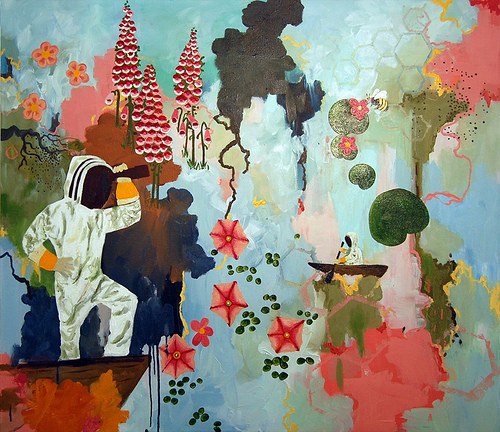 If you think honey is a healthy substitute for sugar, you’re right – but watch out for that alien toxic honey invading U.S. shores! The fact is, about two-thirds of our honey is imported, and a good half of that comes from China, even if it doesn’t say so on the label. And China, well, you know, lovely country and all that, but you really gotta keep an eye on those food issues, even when it comes to something pure and natural like honey.
If you think honey is a healthy substitute for sugar, you’re right – but watch out for that alien toxic honey invading U.S. shores! The fact is, about two-thirds of our honey is imported, and a good half of that comes from China, even if it doesn’t say so on the label. And China, well, you know, lovely country and all that, but you really gotta keep an eye on those food issues, even when it comes to something pure and natural like honey.
Come fly with me beneath the fold and see how you can enjoy pure, healthy honey, worry-free.
1. What’s in Imported Honey?
Cloramphenicol is a banned antibiotic that began showing up in Chinese honey a few years ago. According to a recent investigation by the Seattle P.I., the problems persist. Just last year two people were arrested for conspiring to dump tainted honey from China in the U.S.
Sugar has also been a problem in imported honey. In the 1990’s, the FDA found corn sugar and cane sugar in honey imported to the U.S. from Brazil, Mexico, and the Soviet Union, and it continues to update its alert on sugar-adulterated imports.
2. Imported Honey in Disguise
Two words: honey laundering. Honey is like money. It can be transferred all over the world to hide its origins. When some countries banned honey from China, it was simply shipped through non-banned countries and relabled.
When buying ordinary domestic honey, don’t go by the brand name alone. That only tells you if the packager is a domestic company. Check the label. If it doesn’t tell you where the actual honey is coming from, you can call or email the company.
Same goes when you’re buying specialty honey, whether it’s domestic or imported. Check and see if the company uses only local suppliers and is truly offering a unique product, not some blend of honey from who know where.
[social_buttons]
3. Buying Honey at a Farm Stand
Ah, now we’re getting somewhere. Independent farm stands are a great source for home grown products, but they can also carry any number of products from anywhere else. When you see some delicious-looking honey at a farm stand, ask the farmer (or clerk) if it really is local honey.
4. Buying Honey at the Local Farmer’s Market
Farmer’s Markets take a lot of the guesswork out of buying honey. Depending on your market’s regulations, you can be pretty sure that the product comes from local bees.
Now, that doesn’t necessarily mean that all Farmer’s Market honey is organic. If you’re looking for organic honey, ask the vendor about their beekeeping methods.
5. Being Your Own Beekeeper
First it was backyard vegetable gardens. Now it’s dandelion wine and chickens. So why not honey? Beekeeping isn’t for everyone, but if it’s something you’ve been dreaming about, follow your dream. Even city dwellers can be beekeepers. If you have children, contact your local 4-H to find out about programs that show how beekeeping can be fun and safe for all ages.
Image: Alanna Risse at flickr under creative commons. Check out her many beautiful paintings of bees and beekeeping.
h/t to www.consumerist.com for their post on the Seattle PI articles.
I always buy local honey. You can taste and even see the difference!